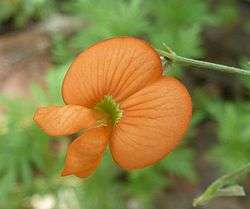Tephrosia
| Tephrosia | |
|---|---|
 | |
| Tephrosia elongata | |
| Scientific classification | |
| Kingdom: | Plantae |
| (unranked): | Angiosperms |
| (unranked): | Eudicots |
| (unranked): | Rosids |
| Order: | Fabales |
| Family: | Fabaceae |
| Subfamily: | Faboideae |
| Tribe: | Millettieae |
| Genus: | Tephrosia Pers. |
| Species | |
|
See text. | |
| Synonyms[1] | |
| |
Tephrosia is a genus of flowering plants in the pea family, Fabaceae. The generic name is derived from the Greek word τεφρος (tephros), meaning "ash-colored," referring to the greyish tint given to the leaves by their dense trichomes.[2] Hoarypea is a common name for plants in this genus.[3]
Uses
Many species in the genus are poisonous, particularly to fish, for their high concentration of rotenone. The black seeds of Tephrosia species have historically been used by indigenous cultures as fish toxins.[4][5] In the last century, several Tephrosia species have been studied in connection with the use of rotenone as an insecticide and pesticide.
Tephrosia vogelii is also one of the many beneficial nitrogen-fixing legumes that can be used in a permaculture forest gardening system as a source of living 'chop and drop' mulch.[6]
Selected species
- Tephrosia apollinea (Delile) Link
- Tephrosia astragaloides Benth.
- Tephrosia candida DC.
- Tephrosia cinerea (L.) Pers.
- Tephrosia clementii Skan
- Tephrosia coronillaefolia Welw. ex Baker
- Tephrosia densiflora Hook.f.
- Tephrosia elongata E.Mey.
- Tephrosia hildebrandtii Vatke[7]
- Tephrosia lindheimeri A.Gray
- Tephrosia macropoda (E.Mey.) Harv.
- Tephrosia nitens Benth. ex Seem.
- Tephrosia odorata Balf.f.
- Tephrosia pondoensis (Codd) Schrire
- Tephrosia purpurea (L.) Pers.
- Tephrosia rosea F.Muell. ex Benth.
- Tephrosia sinapou (Buc'hoz) A. Chev.
- Tephrosia socotrana Thulin
- Tephrosia spinosa (L.f.) Pers.
- Tephrosia tomentosa
- Tephrosia toxicofera
- Tephrosia virginiana (L.) Pers.
- Tephrosia vogelii Hook.f.[8]
References
- ↑ "Genus: Tephrosia Pers.". Germplasm Resources Information Network. United States Department of Agriculture. 2007-10-05. Retrieved 2014-04-05.
- ↑ Quattrocchi, Umberto (2000). CRC World Dictionary of Plant Names: Common Names, Scientific Names, Eponyms, Synonyms, and Etymology. IV R-Z. CRC Press. p. 2642. ISBN 978-0-8493-2678-3.
- ↑ "Tephrosia". Natural Resources Conservation Service PLANTS Database. USDA. Retrieved 8 December 2015.
- ↑ U.S. Food & Drug Administration (March 2006). "Results for search term "tephrosia"". FDA Poisonous Plant Database. U.S. Food & Drug Administration. Retrieved 2008-01-21.
- ↑ Hugh Scott, In the High Yemen, London 1942, p. 238, note C.
- ↑ Koigi, Bob (November 2011). "Tephrosia Leaf Offers Low-Cost Tick Protection". New Agriculturalist.
- ↑ Bussmann, R. W., et al. (2006). Plant use of the Maasai of Sekenani Valley, Maasai Mara, Kenya. J Ethnobiol Ethnomed 2 22.
- ↑ "GRIN Species Records of Tephrosia". Germplasm Resources Information Network. United States Department of Agriculture. Retrieved 2010-10-25.
External links
| Wikimedia Commons has media related to Tephrosia. |
| Wikispecies has information related to: Tephrosia (Plantae) |